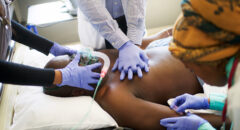 (BlackDoctor.org) Heart disease is the No. 1 killer of American men and women. But, it doesn’t have to be.
(BlackDoctor.org) Heart disease is the No. 1 killer of American men and women. But, it doesn’t have to be.
Heart failure affects some 4.6 million Americans. Roughly 550,000 people are diagnosed with heart failure each year. It is the leading cause of hospitalization in people older than 65. Your heart is an amazing organ. It continuously pumps oxygen and nutrient-rich blood throughout your body to sustain life. This fist-sized powerhouse beats (expands and contracts) 100,000 times per day, pumping five or six quarts of blood each minute, or about 2000 gallons per day. As the heart beats, it pumps blood through a system of blood vessels, called the circulatory system. The vessels are elastic tubes that carry blood to every part of the body.
Blood is essential. In addition to carrying fresh oxygen from the lungs and nutrients to your body’s tissues, it also takes the body’s waste products, including carbon dioxide, away from the tissues. This is necessary to sustain life and promote the health of all the body’s tissues.
There are three main types of blood vessels:
- Arteries: They begin with the aorta, the large artery leaving the heart. Arteries carry oxygen-rich blood away from the heart to all of the body’s tissues. They branch several times, becoming smaller and smaller as they carry blood farther from the heart and into organs.
- Capillaries: These are small, thin blood vessels that connect the arteries and the veins. Their thin walls allow oxygen, nutrients, carbon dioxide and other waste products to pass to and from our organ’s cells.
- Veins: These are blood vessels that take blood back to the heart; this blood lacks oxygen (oxygen-poor) and is rich in waste products that are to be excreted or removed from the body. Veins become larger and larger as they get closer to the heart. The superior vena cava is the large vein that brings blood from the head and arms to the heart, and the inferior vena cava brings blood from the abdomen and legs into the heart.
This vast system of blood vessels — arteries, veins and capillaries — is over 60,000 miles long. That’s long enough to go around the world more than twice! Blood flows continuously through your body’s blood vessels. Your heart is the pump that makes it all possible.
By Glenn Ellis, Executive Editor, BlackDoctor.Org







